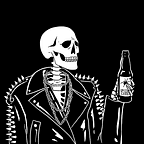Dissecting the Buddhist spirituality of German dance legends Scooter
Often considered plain entertainment, Scooter frontman H.P. Baxxter infuses his lyrics with Buddhist philosophy. As they get the dancefloor Hyper, Hyper, the message is transcendence. Take a closer look at the lyrics to uncover the koans, Zen riddles, and Buddhist symbolism.
How Much Is The Fish?
Titled with a profound rhetorical question, you can find Buddhist messages throughout the track, such as in the second verse:
We’re breaking the rules
Ignore the machine
You won’t ever stop this
The chase is better than the catch
This points at the guilt tradition of Judeo-Christianity. You are already whole and there is nothing to achieve or suffer as a price to pay for enlightenment. The chase is better than the catch, because there is no catch, so there is no chase. In the chorus that follows:
By the way, how much is the fish?
How much is the fish?
Yiiiha!
Sunshine in the Air!
H.P. Baxxter once more underscores the fact that the song’s question has no answer. The answer is not important, since there is no catch. He even gets metaphysical in the last line by commenting on the interpenetration of light and the molecules that make up the air we breathe in.
Hyper, Hyper
A 1995 lecture which doesn’t distill concepts, but instead refers to other acclaimed teachers such as Carl Cox, Sven Väth, and Laurent Garnier. The song ends with a simple instruction to meditate, even without Baxxter’s presence:
Sit there
Be good
Bye-bye!
Bora! Bora! Bora!
The third verse primes the listener for its poetic message by a playful allusion to Shakespeare: “To jump or not to jump, that is the question.” The verse concludes with Buddhist poetry by H.P. Baxxter himself:
We are still alive
And lyrics fly
like birds in the sky
Nessaja
Scooter’s most celebrated Buddhist anthem opens with an encouragement, a call to awakening, written by H.P. Baxxter and set to the melody of rock musician and peace activist Peter Maffay’s song of the same name:
Always lived my life alone
Been searching for a place called home
I know that I’ve been cold as ice
Ignored the dreams, too many lies
Somewhere deep inside, Somewhere deep inside me
I found … the child I used to be
And I know that it’s not too late
Never
Too late…
He then opens the song with profoundly cryptic messages which, to date, nobody has been able to solve, such as: “3AM! The painted cow!” and “It’s not a bird, it’s not a plane… It must be Dave who’s on the train…”
Maria! I Like It Loud
People long wondered whether H.P. was intentionally sharing his wisdoms or whether it was just a matter of his character. After years of speculation, Scooter finally teamed up with the guru Marc Acardipane to confirm that, yes, Baxxter was in fact aware of his role:
“Skibadee, skibadanger
I am the rearranger”
The Logical Song
Throughout their career, Scooter have hinted at their impermanence and the illusion of time through song titles like Scooter Forever, Call Me Mañana, Unfuture, and Fuck Forever. Other songs give specific instructions or riddles to meditate upon, such as Listen and The Question is What is the Question?
None of those songs however, are as celebrated as Scooter’s incorporation of Supertramp’s Logical Song in 2001. The song alludes to their secret alter ego identity, Ratty. On the track, Baxxter can be heard shouting “love, peace and unity”, before referring to the KLF, also known as The Justified Ancients of Mu Mu, famed for burning a million Great British pounds in an act of separation from materialism.
At the end of The Logical Song, H.P. Baxxter finally concludes the meditation initiated in Hyper, Hyper, as he instructs his followers to finally get up:
Stand up!
Once again!
We’re gettin’ jiggy!
Siberiaaaaaaaaaaaaaa!
Yay!
Goodbye!
